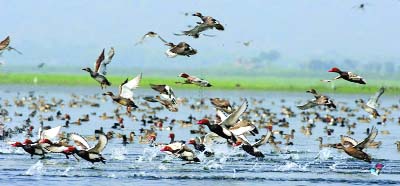
Md Mosabbir Ali back from Hakaluki Haor :
Arrival of migratory birds in Hakaluki Haor this year is increasing than last survey year 2016.
After compiling organizers told this correspondent on Sunday afternoon.
About 58,289 birds of 50 species were counted during a survey done on two days (04th & 05th February). The number was 34,264 birds of 56 species were counted in 2016, 21,631 surveys survey year 2015.
Migratory birds have started flocking to Hakaluki Haor in Moulvibazar, the biggest lake in the country, delighting visitors with their chirping and fluttering.
Birds of different species have come earlier this year and their number is also increase than last years, bird watchers said.
Team led by National Coordinator of Waterfowl Census in Bangladesh and prominent bird specialist Enam Ul Haque conducted the survey.
The survey was organised by Bangladesh Birds Club and it was funded by CREL Project of USAID.
Hakaluki haor comprising 18115 hectares is spread over six upazilas in Moulvibazar and Sylhet districts.
Bird specialist Enam Al Haque after survey told this correspondent on Sunday that they counted 58,289 birds of 50 species in 40 water bodies of Hakaluki Haor. One third migratory birds coming in this year increase than last survey year, birds are coming depends on environments, he added.
Majharul Islam Jahangir, Regional coordinator Crel project (USAID’s Climate-Resilient Ecosystems and Livelihoods (CREL) Project) told this correspondent environment friendly aquatic tree like Hizol, Koroch Boran, Murta is being planted in Chatalbil and Dohobil beels to create resting places for birds.
Guards have been appointed to protect Hijol and Koroch plants in the haor. A large number of aquatic trees have been planted and birds’ sanctuaries created at different points. Arrival of birds is increasing after the steps, he said.
In 1999, the DoE declared Hakaluki Haor an ecologically critical area as its natural environment with aquatic trees and plants like Hijal and Koroch were being destroyed, resulting in decrease in arrival migratory birds.
Arrival of migratory birds in Hakaluki Haor this year is increasing than last survey year 2016.
After compiling organizers told this correspondent on Sunday afternoon.
About 58,289 birds of 50 species were counted during a survey done on two days (04th & 05th February). The number was 34,264 birds of 56 species were counted in 2016, 21,631 surveys survey year 2015.
Migratory birds have started flocking to Hakaluki Haor in Moulvibazar, the biggest lake in the country, delighting visitors with their chirping and fluttering.
Birds of different species have come earlier this year and their number is also increase than last years, bird watchers said.
Team led by National Coordinator of Waterfowl Census in Bangladesh and prominent bird specialist Enam Ul Haque conducted the survey.
The survey was organised by Bangladesh Birds Club and it was funded by CREL Project of USAID.
Hakaluki haor comprising 18115 hectares is spread over six upazilas in Moulvibazar and Sylhet districts.
Bird specialist Enam Al Haque after survey told this correspondent on Sunday that they counted 58,289 birds of 50 species in 40 water bodies of Hakaluki Haor. One third migratory birds coming in this year increase than last survey year, birds are coming depends on environments, he added.
Majharul Islam Jahangir, Regional coordinator Crel project (USAID’s Climate-Resilient Ecosystems and Livelihoods (CREL) Project) told this correspondent environment friendly aquatic tree like Hizol, Koroch Boran, Murta is being planted in Chatalbil and Dohobil beels to create resting places for birds.
Guards have been appointed to protect Hijol and Koroch plants in the haor. A large number of aquatic trees have been planted and birds’ sanctuaries created at different points. Arrival of birds is increasing after the steps, he said.
In 1999, the DoE declared Hakaluki Haor an ecologically critical area as its natural environment with aquatic trees and plants like Hijal and Koroch were being destroyed, resulting in decrease in arrival migratory birds.

